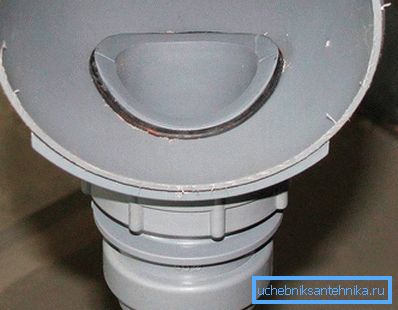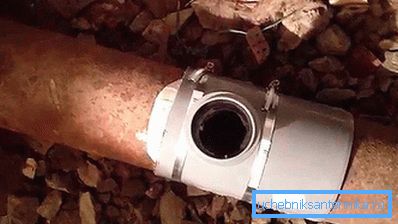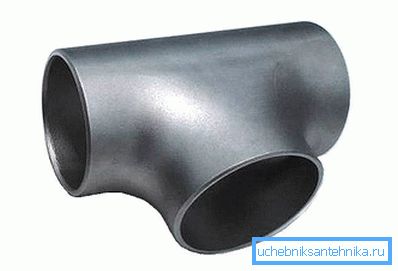How to crash into a sewer riser
During the operation of a private house, country house or apartment, it may be necessary to insert a pipe into the urban network to connect to the sewage system. When the water supply system of the sewage system is steel, then the situation is simple - a piece of pipe is cut off, a tee is welded in instead, and then a pipe is brought to it, which will go to the house. Consider the various options for sidebar.
Among the pipes you can list the most common ones:
- PVC;
- cast iron;
- sometimes steel.
Insert in the PVC pipe

There are some difficulties with plastic pipes. For example, one of them is to connect pipes with a socket inserted into a pipe going to a house. During the mortise works, the main pipe is divided into two others, smaller in diameter, for joining of which a connecting pipe with a pipe section will be used.

Insertion in the cast iron pipe

When connected to a cast iron pipe, you must have a grinder with you, on which the disk for metal will be fixed. You can, like experienced locksmiths, use a chisel and hammer. In this case, chisels make notches on the iron pipe, and then with the help of a hammer, the pipe bangs them carefully. But without experience and preliminary practice it is better not to do it yourself.
In addition to the grinder, you will need a file. It is convenient for them to cut the burrs. If burrs are left behind, then fats and fecal mixtures flowing through the sewage system will remain on them.
Tip! If the sewage system after repair is not immediately put into operation, it is necessary to carry a plug installed on the tee. If it is not delivered, a foul odor from the effluent flowing through the tower will spread through the apartment or house.
To insert a pipe, it is necessary to cut a piece of a riser or pipe that performs such a role. A tee is put on one side of the cut pipe, as a rule, on the bottom side. On the upper part of the riser fix compensating pipe. After his shift, inserting a narrow part of the tee. Work on cutting off the riser should be performed carefully measuring all. Otherwise, cutting off more than necessary, will have to build up the pipe. To cut everything as accurately as possible, you need to make a simple plan on which the position of the fittings will be marked. The cut in the pipe should be equal in length to the size of the compensator.
All work is done in stages:
- We note where the strut piece will be cut, and delete this part.
- After the burrs are trimmed, a file is required. Such burrs will be not only on the cast iron, but also on the plastic pipe.
- The pipe must be lubricated with a sealant from the outside, on the part where the compensating pipe will be located. It is necessary to coat with sealant right next to the incision, not further.
- Then a compensating pipe is tightened onto the pipe, and it must be fully worn so that the tee can still be pulled from above.
- The second pipe is also coated with a sealant and a tee is attached to it.
- Then the sealant is applied to the narrow side of the compensating pipe, after which it gradually descends through the pipe, entering the tee in the narrow part - into the socket.
- If the repair is not planned for the next day, or the sewage pipeline is going further, a plug is put on the third end of the tee, which will be a continuation of the pipe to the house.
Tip! In those cases when the riser pipe is loose, you need to purchase a clamp used for plastic sewage and fix the system. Due to this clamp, the pipe will not be able to slide down, which would cause the pipes to undock, violating the integrity of the connection with the tee.

Cast iron can not be cut. How to do it? Consider below.
- You must have a small piece of plastic pipe with a tap. It is important to pay attention to the fact that this pipe was of the same diameter as the pipe.
- Half a pipe is cut from the finished, matched piece with a tap, so that the insert can be more reliably closed. You should have an overhead clutch with a tap.
- In the very place of the inset, a hole is cut to the size of the nozzle.
- In the flange, the inner surface is lubricated with a sealant that does not dry out. Then the same sealant is applied to the space along the contour of the hole, but at the same time 1 cm to the pipe should be without sealant.
- The flange of the curvilinear form is superimposed on the pipe, after which it is tightened with clamps. Clamps should be tightened, and this should be done until the sealant starts to be squeezed out from under them.
- Sealant that has come out from under the hose clamps must be removed by wiping it with a cloth. If the pressure in the pipe is not very high, tape can be temporarily used instead of clamps.
Insert in a steel pipe through a tee

How can I insert steel pipes? Through the tee. To do this, the main tube is cut in two places along the lines located next to each other. The width of the piece to be cut should correspond to the size of the inserted tee in the form of a coupling that will fit on the pipe part.
Tip! Before the sewage pipe is cut, care should be taken to ensure that the water supply system in the riser is disconnected and that nobody has used the sewage system for some time. It is best to do the sidebar work during the day when most people are at work.
At the edges of the ends, the pipe and the tee are welded so that there is no leakage. This requires electric welding, connected to an electrical network with a voltage of 220 V or 380 V (depending on the type of welding selected), and electrodes of 2 × 3 mm. The most important thing that is needed in this situation is the experience of welding. Since there should be no leakage in the pipe, such work should be carried out by an experienced welder with many years of experience, and not by an amateur welder who can weld the pipe firmly but not tightly.
For a more detailed acquaintance with the sewage system and the possibility of subsequent self-repair, we recommend to read the article:
- How to make a sewage private house.
- Installation of sewer system.
- How to replace the sewer riser in the apartment.
- How to properly connect sewer pipes.
- Sewage layout with their own hands.
- Laying of sewer pipes on the floor.
- Temporary sewage.